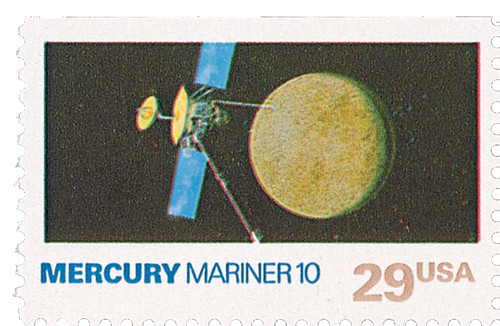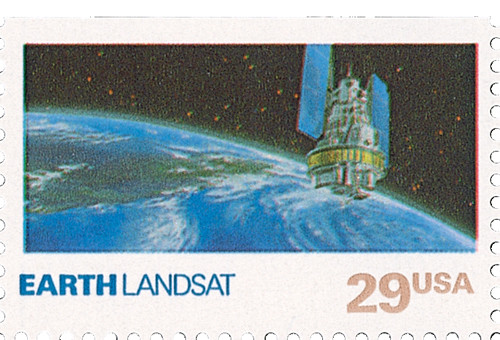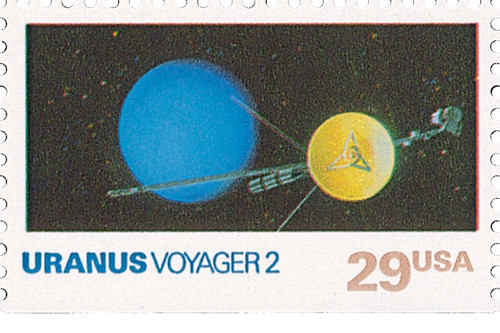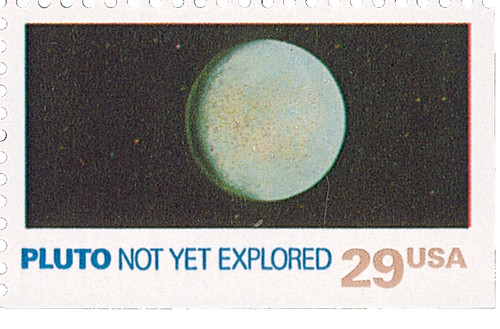
# 2571 - 1991 29c Space Exploration: Moon
US #2571
1991 Moon
- Part of set picturing nine planets and Earth’s moon
- Issued as part of Stamp Collecting Month
Category of Stamp: Commemorative
Set: Space Exploration
Value: 29¢
First Day of Issue: October 1, 1991
First Day City: Pasadena, California
Quantity Issued: 33,394,800
Printed by: Bureau of Engraving and Printing
Printing Method: Photogravure
Format: Booklets – 2 panes of 10 in each
Perforations: 11
Reason the stamp was issued: The set of Space Exploration stamps was issued in honor of the Voyager 2 space probe passing Neptune and the 11th annual Stamp Collecting Month.
About the stamp design: The Moon stamp pictures the Earth’s moon and the Lunar Orbiter. Five of these were launched in 1966 and ’67. They photographed the surface of the moon in detail so landing sites could be determined for the future Apollo missions.
These stamps were the first by Ron Miller, a former artist for the Smithsonian Institution’s National Air and Space Museum. He was asked to picture each of the Sun’s nine planets and the Earth’s moon with a spacecraft. This was to tie in the idea of America’s exploration of space. His original acrylic paintings were larger than those normally used for stamp art. This was to show all the details of the spacecraft.
Special design details: While most of the stamps name the spacecraft shown, the Pluto stamp has “not yet explored,” because no spacecraft had reached that planet at the time. (The space probe New Horizons explored Pluto in 2015.)
First Day City: The First Day of Issue ceremony took place at the Jet Propulsion Laboratory in Pasadena, California, on October 1, 1991, the start of Stamp Collecting Month.
Unusual thing about this stamp: The USPS partnered with Paramount Studios to promote the stamps. The studio was celebrating the 25th anniversary of the Star Trek movies and television series. The stamp designs were unveiled on the bridge of the Starship Enterprise, the space vehicle featured in the series. Flyers promoting the stamps were included in the packaging of Star Trek video cassettes.
About National Stamp Collecting Month stamps: October has been designated by the US Postal Service as National Stamp Collecting Month. The first celebration occurred in 1981 as a way to promote the hobby of collecting stamps. Each year, new stamps are issued in early October to stimulate additional interest, and many philatelic organizations hold special programs during the month. The theme for the 1991 celebration was “Journey to a New Frontier… Collect Stamps.”
History the Space Exploration stamps represent: Uncovering the mysteries of the universe has been a pursuit of scientists and dreamers for all time. With the invention of telescopes, astronomers discovered some of the wonders of space. With the space age, researchers began sending spacecraft outside of Earth’s orbit to gain further insight into the planets of our solar system. Manned missions were followed by unmanned missions with the capability of traveling to distant planets. These stamps show some of the spacecraft and the images of the planets they captured as they flew by. Discoveries continue to be made with the space probes that still travel through our solar system.
History the Earth and Lunar Orbiter stamp represents:
The Lunar Orbiter program was launched in 1966, and aimed at capturing images of the moon’s surface to plan possible landing sites. As NASA made preparations, they discovered that Boeing and Eastman Kodak had been working on exactly what they needed – a spacecraft with an onboard camera system.
Lunar Orbiter I launched on August 10, 1966, and 92 hours later it was orbiting the moon. It was a flying photo lab – with a camera system taking up about one-third of the ship. The onboard camera had dual lenses that took two photos at once. While one lens took medium-resolution wide-angle images, the other captured high-quality closeups of these areas in greater detail. The unmanned machinery then exposed, developed, and processing the film, all while orbiting the moon amidst extreme hot and cold temperatures.
Once the photos were processed, an electron beam scanned each of them and then transmitted them back to Earth over radio signals. Four other Lunar Orbiters followed the first, and together they mapped 99 percent of the moon.
Scientists at NASA used these photos to investigate 20 potential landing sites. To do so, they made giant prints, laid them on the floor, and walked on them to figure out which would work best.
While the mission was going smoothly, some at NASA debated pointing the Lunar Orbiter’s camera at Earth. It wasn’t planned ahead of time and was a significant risk. There was a chance the craft wouldn’t turn back toward the moon. Eventually, NASA officials decided they really wanted the picture and agreed no one would get in trouble if the camera didn’t reposition correctly. So on August 23, the Lunar Orbiter captured the earthrise – our planet rising above the moon’s horizon.
Once it was received back on Earth, the photo was made into posters that were widely dispersed. When their mission was over, the Lunar Orbiters were crashed into the moon so their signals wouldn’t interfere with later missions.
US #2571
1991 Moon
- Part of set picturing nine planets and Earth’s moon
- Issued as part of Stamp Collecting Month
Category of Stamp: Commemorative
Set: Space Exploration
Value: 29¢
First Day of Issue: October 1, 1991
First Day City: Pasadena, California
Quantity Issued: 33,394,800
Printed by: Bureau of Engraving and Printing
Printing Method: Photogravure
Format: Booklets – 2 panes of 10 in each
Perforations: 11
Reason the stamp was issued: The set of Space Exploration stamps was issued in honor of the Voyager 2 space probe passing Neptune and the 11th annual Stamp Collecting Month.
About the stamp design: The Moon stamp pictures the Earth’s moon and the Lunar Orbiter. Five of these were launched in 1966 and ’67. They photographed the surface of the moon in detail so landing sites could be determined for the future Apollo missions.
These stamps were the first by Ron Miller, a former artist for the Smithsonian Institution’s National Air and Space Museum. He was asked to picture each of the Sun’s nine planets and the Earth’s moon with a spacecraft. This was to tie in the idea of America’s exploration of space. His original acrylic paintings were larger than those normally used for stamp art. This was to show all the details of the spacecraft.
Special design details: While most of the stamps name the spacecraft shown, the Pluto stamp has “not yet explored,” because no spacecraft had reached that planet at the time. (The space probe New Horizons explored Pluto in 2015.)
First Day City: The First Day of Issue ceremony took place at the Jet Propulsion Laboratory in Pasadena, California, on October 1, 1991, the start of Stamp Collecting Month.
Unusual thing about this stamp: The USPS partnered with Paramount Studios to promote the stamps. The studio was celebrating the 25th anniversary of the Star Trek movies and television series. The stamp designs were unveiled on the bridge of the Starship Enterprise, the space vehicle featured in the series. Flyers promoting the stamps were included in the packaging of Star Trek video cassettes.
About National Stamp Collecting Month stamps: October has been designated by the US Postal Service as National Stamp Collecting Month. The first celebration occurred in 1981 as a way to promote the hobby of collecting stamps. Each year, new stamps are issued in early October to stimulate additional interest, and many philatelic organizations hold special programs during the month. The theme for the 1991 celebration was “Journey to a New Frontier… Collect Stamps.”
History the Space Exploration stamps represent: Uncovering the mysteries of the universe has been a pursuit of scientists and dreamers for all time. With the invention of telescopes, astronomers discovered some of the wonders of space. With the space age, researchers began sending spacecraft outside of Earth’s orbit to gain further insight into the planets of our solar system. Manned missions were followed by unmanned missions with the capability of traveling to distant planets. These stamps show some of the spacecraft and the images of the planets they captured as they flew by. Discoveries continue to be made with the space probes that still travel through our solar system.
History the Earth and Lunar Orbiter stamp represents:
The Lunar Orbiter program was launched in 1966, and aimed at capturing images of the moon’s surface to plan possible landing sites. As NASA made preparations, they discovered that Boeing and Eastman Kodak had been working on exactly what they needed – a spacecraft with an onboard camera system.
Lunar Orbiter I launched on August 10, 1966, and 92 hours later it was orbiting the moon. It was a flying photo lab – with a camera system taking up about one-third of the ship. The onboard camera had dual lenses that took two photos at once. While one lens took medium-resolution wide-angle images, the other captured high-quality closeups of these areas in greater detail. The unmanned machinery then exposed, developed, and processing the film, all while orbiting the moon amidst extreme hot and cold temperatures.
Once the photos were processed, an electron beam scanned each of them and then transmitted them back to Earth over radio signals. Four other Lunar Orbiters followed the first, and together they mapped 99 percent of the moon.
Scientists at NASA used these photos to investigate 20 potential landing sites. To do so, they made giant prints, laid them on the floor, and walked on them to figure out which would work best.
While the mission was going smoothly, some at NASA debated pointing the Lunar Orbiter’s camera at Earth. It wasn’t planned ahead of time and was a significant risk. There was a chance the craft wouldn’t turn back toward the moon. Eventually, NASA officials decided they really wanted the picture and agreed no one would get in trouble if the camera didn’t reposition correctly. So on August 23, the Lunar Orbiter captured the earthrise – our planet rising above the moon’s horizon.
Once it was received back on Earth, the photo was made into posters that were widely dispersed. When their mission was over, the Lunar Orbiters were crashed into the moon so their signals wouldn’t interfere with later missions.
















